
Gustavo Adrián Cerati Clarke was an Argentine musician, singer-songwriter and record producer, who gained international recognition for being the leader, vocalist, composer and guitarist of the rock band Soda Stereo. He is widely considered by critics, specialized press and musicians as one of the most important and influential artists of Latin rock. Rolling Stone magazine ranked Cerati as the 33rd best rock singer of all time.

El Otro Yo is an Argentinean alternative rock band. They made their debut in the late '80s / early '90s, with a demo tape called Los Hijos de Alien, followed by Traka-Traka. Later on, the group successfully founded its own label, Besotico Records, thus sealing their independent personality. EOY is the independent group with the most albums recorded in the 1990s. The band shared tours and stages with bands such as Pixies, Smashing Pumpkins, Marilyn Manson, Incubus, Yo La Tengo, Molotov, Café Tacuba, Todos Tus Muertos, Los Brujos, Nick Cave and the Bad Seeds, Silverchair, Soda Stereo, Robi Draco Rosa, The Offspring and Placebo, among others. They have played extensively all over Latin American and the United States. El Otro Yo is the third band in the world to transform their official website into a social network, which is called Comunidad EOY. They are also the first Latin American band to offer their own application for iPhone, iPad and iPod Touch users.
Argentine rock is rock music composed or performed by Argentine bands or artists mostly in Spanish.

Sumo was a 1980s Argentine alternative rock band, heavily influenced by post-punk and reggae. Led by Italian-born Scottish Luca Prodan, it remained underground for most of its short activity but was extremely influential in shaping contemporary Argentine rock. Sumo is credited with introducing British post-punk to the Argentine scene, mostly by songs with lyrics in English, and with providing a visceral counterpoint to the progressive and nueva canción influences then dominant in the country's rock en español.

El nervio del volcán is the fourth and final album by Mexican rock band Caifanes, released in the summer of 1994.

Soda Stereo is the debut album recorded by Argentine rock band Soda Stereo, released in August 27, 1984, through Discos CBS. It was produced by Federico Moura, then leader of the band Virus.
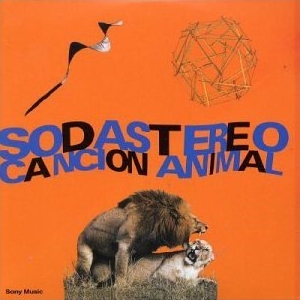
Canción Animal is the fifth album released by the Argentine rock band Soda Stereo, released in September 1990. Many of the songs on the album are among the band's most popular, such as one of their biggest hits "De Música Ligera", the last song played in Soda Stereo's last concert in 1997, "Hombre al agua", "Un Millón de Años Luz", "Te para tres" and others. It is considered one of the best and most influential albums in the history of Latin American rock music. Many regard it as the best album to ever come out of South America. In 2007, the Argentine edition of Rolling Stone ranked it 9 on its list of "The 100 Greatest Albums of National Rock". The album sold 500,000 copies in Argentina alone.
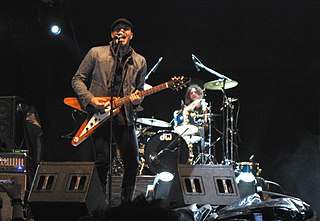
Catupecu Machu is an Argentine rock band, usually classified as within Rock en Español. Its current band members are Fernando Ruiz Díaz on vocals and guitar; Sebastián Cáceres on bass guitar; Agustín Rocino on drums; and Macabre González on keyboards and samplers.
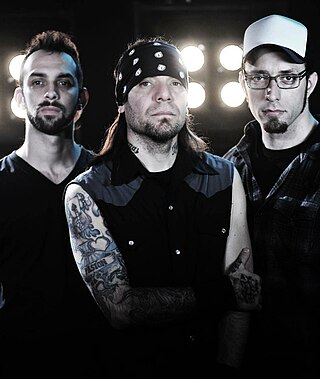
Carajo was an Argentinian rock band from Buenos Aires. It was formed in 2000 with Marcelo "Corvata" Corvalan on bass and vocals, Andres "Andy" Vilanova on drums and Hernan "Tery" Langer on guitar and backing vocals. The first two share the history of having been part of the band A.N.I.M.A.L. In 2020, the band's breakup was announced.
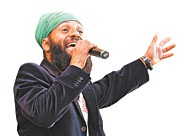
Todos Tus Muertos is a rasta-punk band from Argentina formed in Buenos Aires, in 1985. The longtime line-up comprised by a young vocalist Fidel Nadal, Horacio "Gamexane" Villafañe on guitar, Felix Gutiérrez on bass, and drummer Pablo Potenzoni. They achieved international success throughout the 1990s. The band was part from the second Argentine punk movement that emerged during the mid-1980s. By 2015, a reunion show was announced with Fidel Nadal, Felix Gutiérrez and Pablo Molina at the Jamming Festival in Bogotá, Colombia on 5 June 2016, and more recently three more show in Chile and Mexico.
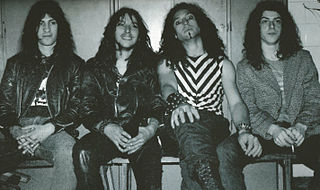
V8 was an Argentine heavy metal band formed in 1979, one of the first notable Argentine and Latin America bands of that genre. After its dissolution former members have continued their careers starting other heavy metal bands, Hermética, Horcas, Rata Blanca, Logos and Almafuerte.

Soda Stereo was an Argentine rock band formed in Buenos Aires in 1982. The band's lineup consisted of lead singer and guitarist Gustavo Cerati, bassist Zeta Bosio, and drummer Charly Alberti. During their career, the band issued seven studio albums before disbanding in 1997.
Índica is an Argentine psychedelic rock music band formed in the year 2006 in Buenos Aires, Argentina by Rubén Farzati and David Vera. The band is named after a counterculture art gallery of the late 60s, Indica Gallery, located in Masons Yard, London, England.

The 11th Annual Latin Grammy Awards were held on Thursday, November 11, 2010, at the Mandalay Bay Events Center in Las Vegas, Nevada. It was the third time the annual event had taken place at this location. The eligibility period for recordings to be nominated was July 1, 2009 to June 30, 2010. Nominations were announced on September 8, 2010. On September 14, 2010, it was announced that the Latin Recording Academy Person of the Year honoree would be Plácido Domingo. The big winners of the night were Camila, Juan Luis Guerra and Gustavo Cerati with three awards.

La Vida Bohème is a rock band from Caracas, Venezuela, formed by Rafael Perez, Daniel De Sousa, Sebastian Ayala, and Henry D'Arthenay in late 2006 and mid-2007. The band takes influence from late '80s punk, disco, funk, electronic music, jazz, salsa, reggae and dance music. Their first recording is a self-titled EP that includes three songs
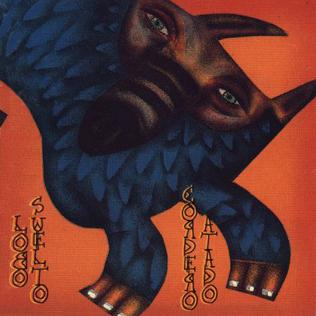
Cordero Atado is the seventh album by Argentine rock band Patricio Rey y sus Redonditos de Ricota, released in 1993.

Richter is an electronic rock band from Buenos Aires, Argentina.

Trotsky Vengarán is an Uruguay rock band formed in 1991, by Guillermo Peluffo, lead singer, Hugo Diaz and Ignacio Guasch on guitars, Guillermo "Cuico" Perazzo on drums and Marcelo Abreu on bass. Since the very beginning they decided they were going to play hard and melodic rock. They were influenced by groups such as Ramones, Beastie Boys, AC/DC, Sex Pistols and other 50's and 60's bands. Their style is clearly defined as punk rock, but with hardcore characteristics. The themes in their songs vary greatly, dealing with political, social, and cultural everyday issues. In 1994 they released their first album, called Salud, Dinero y Dinero. ".

Oktubre is the second studio album by Argentine rock band Patricio Rey y sus Redonditos de Ricota, released in 1986. It is the band's last album to feature to Piojo Ávalos, Tito D'Aviero and Willy Crook as band members, who left the band after the tour between late 1986 and early 1987. In 2007, the Argentine edition of Rolling Stone ranked it fourth on its list of "The 100 Greatest Albums of National Rock".
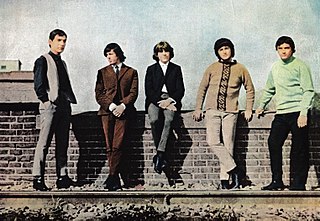
Los Gatos Salvajes, from Rosario, Santa Fe in Argentina, were a beat and garage rock band active in the early to mid-1960s, following which members Litto Nebbia and Ciro Fogliatta would go on to form the later, more successful group, Los Gatos. They were one of Argentina's first teenage rock & roll bands, and part of the popular worldwide beat movement inspired by the success of the Beatles and the British Invasion. They enjoyed only limited record sales, despite some degree of success in their television appearances, but are recognised as a pioneering group in Argentina.


















